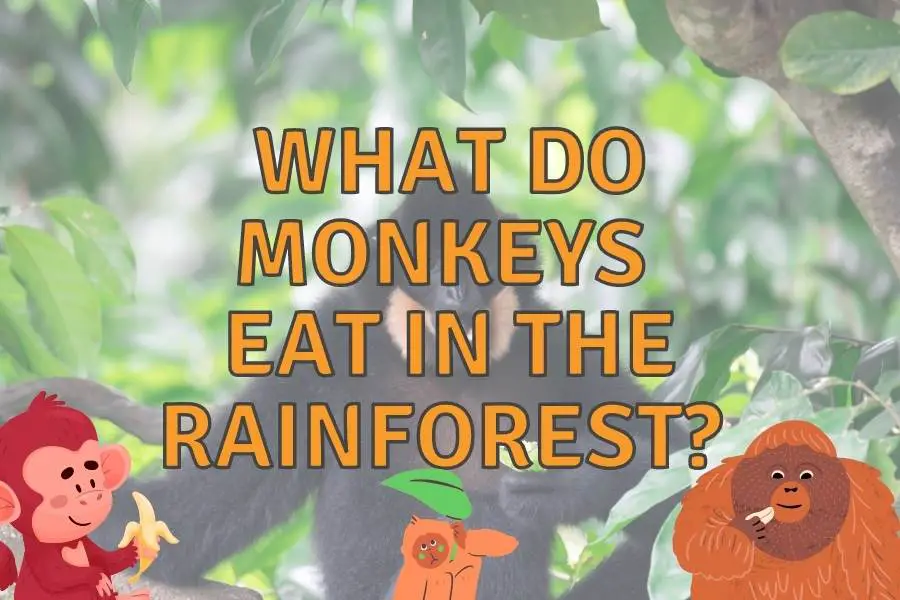The rainforest is a diverse ecosystem with a diverse range of plant and animal life. This makes it an ideal place to find food for many animals including monkeys!
More than 30 species of monkeys live exclusively in the rainforest of the world (and more than 300 species in total!), where they eat everything from fruit to small animals!
Monkeys live in the rain forests of Africa, South America, and Southeast Asia, where they eat numerous fruits, plants and insects. The average diet of a monkey in the rainforest consists mainly of fruit (around 75%), leaves, stems, and other plant material (>20%), smaller animals and insects (<10%).
However, some monkeys living in rainforests eat mostly leaves and are therefore considered folivores (leaf eaters).
In many ways, the diets of monkeys living in the rainforest are similar to what our, human, diets used to be before we invented fire, which enabled us to cook and eat larger animals (see my quick recap of the human dietary history, and how it relates to the monkey diet, at the end of this article!).
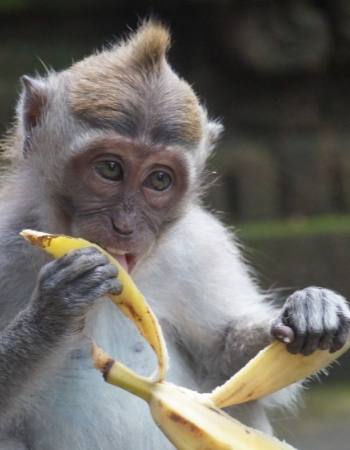
Contents
What do Amazonian monkeys eat?
Most monkey species in the Amazon rainforest eat fruit as is the case in most rainforests all over the world. The amount of fruit eaten by rainforest monkeys reflects the energy content, which is high due to the immense sugar content in fruits.
However, monkeys have a hard time covering their protein needs with fruits alone, so most rainforest monkeys will supplement their plant-based diet with animal protein in the form of insects.
They will mostly eat smaller insects such as ants, worms, or beetles, but they may also sometimes steal eggs or hunt for small mammals such as mice or lizards!
But many rainforest monkeys get their protein needs covered entirely without eating animals.
Monkeys such as the proboscis monkey, Howler monkeys, Langurs, and the Red-Shanked Douc predominantly eat leaves, but still manages to survive – but how?
They can do this because they get most of their protein needs covered from the bacteria in their stomachs that digest the dietary fibers of the rough plant material that they eat!
These bacteria digest the plant material and in turn the monkey digests the bacteria, including their proteins, vitamins and fat!
This is exactly how ruminants like cows get their nutrients, which I wrote another article about here.
Otherwise, some monkeys living in the rainforest will supplement with the many nuts and seeds available. Nuts and seeds provide the monkeys with important fats and amino acids to supplement their fruit and leaf-based diets.
There are many physiological traits of monkeys that reveal what type of diet they prefer, and the type of teeth of a monkey reveals a lot about their preferred food items! But although some monkeys have pointy sharp fangs, this does not mean that they are predators!
Most monkeys and apes like the Gorilla and Orangutan are in fact omnivores and will eat both plants and animals.
Below, I will dive into some of the most interesting monkeys in the rainforest and take a closer look at their individual diets!
What Do Spider Monkeys Eat in the Rainforest?
The Spider monkey is one of the largest types of monkeys that live in the tropical forests of Central and South America. Because they are so large they are often hunted and eaten by people.
The spider monkey is one of the true omnivores of the rainforest and it will eat everything from fruits and leaves to insects and smaller animals! However, whereas most of the spider monkeys diet consist of fruits and seeds, they will also catch small insects, frogs, spiders and even birds for food!
They have very long limbs, especially their arms, which is why they are named after their (very) distant insect relative…

Spider monkeys are very social and forage in groups for fruits and other plant material. Spider monkeys are one of the smartest species of New World monkeys.
The hands and feet of spider monkeys have opposable thumbs and big toes that help them to climb through trees with ease.
They also rely heavily on their long, strong tails for balance and to grab onto branches during climbing. They live very high up (98 ft, 30 m) in the rainforest trees.
- Monkey Name: Black spider Monkey
- Type of monkey (Family): Atelidae
- Type of monkey (Genus): Ateles
- Species Name: paniscus
- Adult Body Weight (lbs): 19.17
- Adult Body Weight (Kg): 8.69
- Size (Inches): 22.6
- Maximum lifespan (years): 37.8
- Newborn Weight (lbs): 1
- Pregnancy Duration (months): 7.6
- Typical Group Size: 20
- Diet type: Omnivorous
- Monkeys per Square Mile: 3
Bald Uakari
The bald Uakari is a type of monkey that is found in the Amazon rainforest where it prefers to live near rivers in flooded forests. Because of this they only live high up in the trees during the rainy season.
The diet of Bald Uakaris consists mainly of fruits, insects and seeds. Their jaw and teeth are specially adapted so that it can break the hardest seeds that other animals cannot eat and their unique jaw strength also enables them to chew through tough bark and stem material!
They live in large groups of up to 100 individuals and travel large distances of around 3 miles (5 km) every day to find enough food to cover their energy needs!

They are characterized by their bright red hair and bald head, which helps them to stay cool in the hot rainforest. The males with the reddest faces attract most females.
The females have a special gland that releases a smell that encourages the males to mate with them.
They fiercely defend their territory by making loud noises and moving their tail.
- Monkey Name: Bald Uakari
- Type of monkey (Family): Pitheciidae
- Type of monkey (Genus): Cacajao
- Species Name: calvus
- Adult Body Weight (lbs): 7.54
- Adult Body Weight (Kg): 3.42
- Size (Inches): 21.28
- Maximum lifespan (years): 27
- Newborn Weight (lbs): Not known
- Pregnancy Duration (months): 6
- Typical Group Size: 23.7
- Diet type: Broad diet
- Monkeys per Square Mile: 5.83
Colombian Red Howler
The Colombian red howler monkey is found throughout the rainforests of Colombia, Venezuela, Equador, Brazil and Peru.
Their fur is reddish-brown in color but this changes as they get older. Their long tail has no hair at the bottom so they can grab onto branches better.
The Colombian Red Howler monkey predominantly eats leaves, which makes up around 65% of its diet. They also eat fruits, but because they are slower than the spider monkeys that also eat fruits and live in the same habitats, they are often forced to get most of their food from leaves.
Their favorite fruits are figs and they will also eat the leaves of the fig trees when searching for the fruits. They will also eat the flowers before the fruits are formed.

The incredibly loud howling sound they make can be heard for several kilometers (3 miles, 5 km) across the rainforest to communicate with different groups that are far away. Singing is mostly done early in the morning when they start to move around to find new feeding areas.
The purpose of this is to chase other groups away so they will have less competition for food. Leaves are the most important their diet. Groups have one dominant male and several females. These monkeys prefer to walk rather than jump between trees.
- Monkey Name: Colombian Red Howler
- Type of monkey (Family): Atelidae
- Type of monkey (Genus): Alouatta
- Species Name: seniculus
- Adult Body Weight (lbs): 14.10
- Adult Body Weight (Kg): 6.39
- Size (Inches): 22
- Maximum lifespan (years): 25
- Newborn Weight (lbs): 0.64
- Pregnancy Duration (months): 6.33
- Typical Group Size: 7.9
- Diet type: Omnivorous
- Monkeys per Square Mile: 17.17
Proboscis Monkey
The Proboscis monkey is only found in Borneo, and it’s named after its large, drooping nose. The male monkeys’ noses can get to be about the size of their entire face!
They live in the mangrove forests near the rivers and have webbed toes, possibly for swimming. They are one of the largest types of monkeys in Asia.
Unlike most other types of monkeys, the Proboscis Monkey is mostly herbivorous, and it mainly eats young leaves, shoots, and unripe fruits. Their bellies are very big because they contain four stomachs so they can ferment the leaves they ingest, which is necessary to extract enough nutrients.
The males with the largest noses are able to make louder honking noises, making them more attractive to the females.

They are usually made fun of and referred to as “Dutch monkeys” by the native people of Borneo as resembling the white, fat, red-nosed sailors that arrived from The Netherlands during the colonization of Borneo.
The babies have a blue face for the first few months after they are born. They live in groups with dominant males but are not very territorial towards other groups living in the same area, probably because there are plenty of leaves to eat.
- Monkey Name: Proboscis Monkey
- Type of monkey (Family): Cercopithecidae
- Type of monkey (Genus): Nasalis
- Species Name: larvatus
- Adult Body Weight (lbs): 27.04
- Adult Body Weight (Kg): 12.2
- Size (Inches): 25.491746049
- Maximum lifespan (years): 21
- Newborn Weight (lbs): 0.992079
- Pregnancy Duration (months): 5.50
- Typical Group Size: 11.25
- Diet type: Broad diet
- Monkeys per Square Mile: 3.47
Colombian White-faced Capuchin
The Colombian white-faced capuchin is found in the rainforest of Colombia. They are popular in the illegal pet trade and are also known as “organ grinder” monkeys because they are often seen performing in street shows.
They have a white face and body with black hair on their head. They often hold their tail in a round, curled position. It lives in large groups in the wild.
The Colombian White-faced Capuchin is a true omnivore and eats fruit, nuts and insects but also many smaller animals such as mice and even tree rats, squirrels, lizards and birds! They may even steal your ice cream or chocolate bar if you are not careful!

They are very smart and have been observed to use tools to get to food and rub certain leaves over their bodies as a way to self-medicate. Sometimes they mix with groups of howler monkeys and have been seen grooming their fur.
Fun fact: The Monkey named Jack from the Pirates of the Caribbean films and Abu from Aladin and Marcel from Friends are Capuchin monkeys!
- Monkey Name: Colombian White-faced Capuchin
- Type of monkey (Family): Cebidae
- Type of monkey (Genus): Cebus
- Species Name: capucinus
- Adult Body Weight (lbs): 6.62
- Adult Body Weight (Kg): 3
- Size (Inches): 14.874811182
- Maximum lifespan (years): 54.8
- Newborn Weight (lbs): 0.52
- Pregnancy Duration (months): 5.3
- Typical Group Size: 18.15
- Diet type: Broad diet
- Monkeys per Square Mile: 10.52
Common Marmoset
The common marmoset is found in the rainforest of South America. They are a very small type of monkey with claws instead of nails, and their fur is a light brown color with white tufts on their ears.
They eat mostly fruit and nectar but also other plant materials, mushrooms, bird eggs, insects, and smaller animals that they are able to catch. They will bite holes into branches and lick the sap or resin that seeps out of the tree. This is a reliable source of food when there are no fruits or insects to find.

Common Marmoset monkeys jump around between trees in a similar way as squirrels do, and live in small family groups where they help raise each other’s young. Two tiny non-identical twins are often born that firmly grasp onto their mother’s coat, who will carry them around.
- Monkey Name: Common Marmoset
- Type of monkey (Family): Cebidae
- Type of monkey (Genus): Callithrix
- Species Name: jacchus
- Adult Body Weight (lbs): 0.63
- Adult Body Weight (Kg): 0.29
- Size (Inches): 8
- Maximum lifespan (years): 16.8
- Newborn Weight (lbs): 0.06
- Pregnancy Duration (months): 4.8
- Typical Group Size: 8.55
- Diet type: Broad diet
- Monkeys per Square Mile: 196.2
De Brazza’s Monkey
The Brazza’s monkey is one of the most widespread monkeys found in the rainforest of Africa but they are hard to find and observe.
The De Brazza’s Monkey eats mostly fruits but will also eat leaves, stems and flowers. Occasionally, they also eat insects and mushrooms.

They prefer to live near rivers and swamps in pairs or small groups. The females are a lot smaller than the males. Their coat is black with a remarkable eyebrow-like pattern in reddish-brown and a white beard. And even the female monkeys have a beard!
They like to hide in dense vegetation where they eat plants and insects but can occasionally go down to the ground to eat. They themselves are eaten by eagles, chimpanzees, leopards, and humans.
- Monkey Name: De Brazza’s Monkey
- Type of monkey (Family): Cercopithecidae
- Type of monkey (Genus): Cercopithecus
- Species Name: neglectus
- Adult Body Weight (lbs): 11.73
- Adult Body Weight (Kg): 5.3
- Size (Inches): 20.07
- Maximum lifespan (years): 26.3
- Newborn Weight (lbs): 0.57
- Pregnancy Duration (months): 5.73
- Typical Group Size: 5
- Diet type: Narrow diet
- Monkeys per Square Mile: 11.20
East Javan Langur
The East Javan langur is found in Indonesia on Java and the surrounding islands. They are known for their golden-white fur and very long tails.
They mainly eat leaves and have special adaptations to their gut to deal with these. They also eat some fruits before they are ripe and supplement their diet with larvae and other insects for protein.
Because there is not much energy in the leaves and their digestion takes a long time, the monkeys are not very active so they do not waste energy.

East Javan Langurs can be found in the middle and some outer edges of the rainforests and mangroves where it stays up in the trees.
They are an endangered species because they have been hunted for their meat and their forests are disappearing.
- Monkey Name: East Javan Langur
- Type of monkey (Family): Cercopithecidae
- Type of monkey (Genus): Trachypithecus
- Species Name: auratus
- Adult Body Weight (lbs): 21.4
- Adult Body Weight (Kg): 9.7
- Size (Inches): 21
- Maximum lifespan (years): 23
- Newborn Weight (lbs): Not known
- Pregnancy Duration (months): Not known
- Typical Group Size: 11
- Diet type: Picky
- Monkeys per Square Mile: 16.21
Emperor Tamarin
The Emperor tamarin is an active and very small monkey found in the Lowland Amazon rainforest. They have a distinctive white mustache and black markings on their face, arms, and legs. They got their name because they resembled a German emperor.
Emperor tamarins live in groups of up to six individuals and eat mostly fruit, flowers, insects, and smaller animals such as frogs, lizards and bird nestlings. They will also eat sap of certain trees including the gum tree from which chewing gum is made!

They live in groups where the males are also helping to rear the young and are known to be better at keeping an eye on them and are more protective than the females. The males often carry around the twin babies while the dominant female searches for food.
Fun fact: An Emperor Tamarin is featured as the pet of the antagonist in the animation picture “Rio”.
- Monkey Name: Emperor Tamarin
- Type of monkey (Family): Cebidae
- Type of monkey (Genus): Saguinus
- Species Name: imperator
- Adult Body Weight (lbs): 0.89
- Adult Body Weight (Kg): 0.40
- Size (Inches): 10
- Maximum lifespan (years): 20.2
- Newborn Weight (lbs): 0.10
- Pregnancy Duration (months): Not known
- Typical Group Size: 5
- Diet type: Picky
- Monkeys per Square Mile: 7.1
Gee’s Golden Langur
Golden Langurs live in small groups in the tree canopy where they mainly eat leaves and flowers. They drink rainwater and dew from leaves and do not come down to the ground to drink.
The diet of the Golden Langur monkeys is fairly narrow and consists mainly of young leaves, unripe fruits, seeds, shoots, flowers, and very few insects.
Like the howler and proboscis monkeys, the stomachs of Golden Langurs have evolved to ferment the food they ingest, so they cannot eat too much sugar and hence they do not eat ripe fruits.
They prefer leaves that will slowly ferment in their stomachs to provide them lasting energy without too much gas generation.

Gee’s Golden Langur is found in the forests of India. These beautiful monkeys are black with golden fur on their heads, backs, and arms.
They are an endangered sub-species of Golden Langurs. This type of monkey is often very calm but can be dangerous if threatened. People in the Himalayas consider it to be sacred, and they are the most endangered monkeys in India.
- Monkey Name: Gee’s Golden Langur
- Type of monkey (Family): Cercopithecidae
- Type of monkey (Genus): Trachypithecus
- Species Name: geei
- Adult Body Weight (lbs): 18.42
- Adult Body Weight (Kg): 8.3
- Size (Inches): 23.8189105
- Maximum lifespan (years): Not recorded
- Newborn Weight (lbs): Not known
- Pregnancy Duration (months): Not known
- Typical Group Size: 11
- Diet type: Narrow diet
- Monkeys per Square Mile: 1
Guatemalan Black Howler Monkey
Howler monkeys are the loudest animal in the world. Their extremely loud voice is used to attract females and scare off other males. These monkeys are the largest type of Howler and live in the lowland tropical rainforests of South and Central America where they avoid riverbanks.
The Guatemalan Black Howler Monkey is very picky with its food and never eats any insects or other animals. They have adapted to mainly eat leaves, but since these do not contain a lot of energy they cannot be very active, so they sleep a lot during the day.
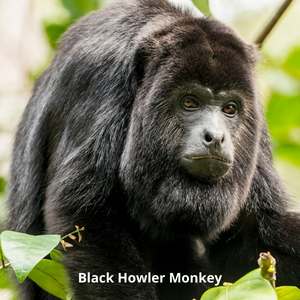
They live in groups with one dominant male and several females, but the females raise their young by themselves.
They belong to the Alouatta genus of monkeys. These monkeys can be found in the Neotropical regions of Central and South America. The Guatemalan Black Howler monkey is the largest of the Howler monkeys and weighs up to 30 pounds (males).
- Monkey Name: Guatemalan black howler
- Type of monkey (Family): Atelidae
- Type of monkey (Genus): Alouatta
- Species Name: pigra
- Adult Typical Body Weight (lbs): 16
- Adult Body Weight (Kg): 8
- Size (Inches): 22.3
- Maximum lifespan (years): 20
- Newborn Weight (lbs): 1
- Pregnancy Duration (months): 6
- Typical Group Size: 5.5
- Diet type: Picky
- Monkeys per Square Mile: 3.3
Lion-tailed Macaque
The Lion-tailed macaque is found in the rainforest of the Western Ghats mountain range of India.
The lion-tailed macaques live in groups and eat fruit, leaves, flowers, seeds, insects, and small vertebrates such as lizards.
They can store food in their cheek pouches, so that they can quickly collect food and run away from danger or competition if needed. When they are in a calm area where they can eat again, they rub their hands on their cheeks to release the food into their mouth and eat it!

They have a distinctive long, black, and silver mane and a golden-brown coat of fur. It is named for its tail that looks like a lion’s tail. It spends most of its life in trees, hiding away from humans.
They have 17 different calls that they use to communicate with each other. Dominant males stick their tails in the air to signal their position in the hierarchy.
- Monkey Name: Lion-tailed Macaque
- Type of monkey (Family): Cercopithecidae
- Type of monkey (Genus): Macaca
- Species Name: silenus
- Adult Body Weight (lbs): 13.21
- Adult Body Weight (Kg): 5.9
- Size (Inches): 21.5
- Maximum lifespan (years): 40
- Newborn Weight (lbs): 0.9173644282
- Pregnancy Duration (months): 5.73
- Typical Group Size: 21
- Diet type: Broad diet
- Monkeys per Square Mile: 0.389
Red-Shanked Douc
The Red-shanked Douc is one of the most colorful monkeys and comes from the rainforests of Southeast Asia. They are mostly arboreal, and they usually live in small groups of up to six individuals.
They mainly eat leaves that have a lot of fiber which they break down in their large stomachs by using bacteria that ferment it. Females will help each other with raising the babies and sometimes even breastfeed others young.

They sometimes come down to the ground to eat dirt with minerals and salt. The tail cannot be used to grasp onto branches and is only used for balance. These monkeys prefer to communicate with each other via facial expressions rather than sound.
- Monkey Name: Red-Shanked Douc
- Type of monkey (Family): Cercopithecidae
- Type of monkey (Genus): Pygathrix
- Species Name: nemaeus
- Adult Body Weight (lbs): 20.7
- Adult Body Weight (Kg): 9.41
- Size (Inches): 24.542139237
- Maximum lifespan (years): 25
- Newborn Weight (lbs): 0.42
- Pregnancy Duration (months): 6
- Typical Group Size: 9.3
- Diet type: Picky
- Monkeys per Square Mile: Not known
Aye-aye “monkey”
The aye-aye is actually a lemur, but I have included it because it is a very interesting example of a nocturnal funny-fingered primate!
They mostly eat insects that they catch in a very peculiar manner!
The Aye-aye rapidly tap the trees with their fingers and listen for an echo caused by the hollow chambers that insects make in the wood.
This unique feeding method is called percussive foraging.
They then use their teeth to make a hole in the bark and use their fingers to extract the insects that are buried deep inside. Apart from eating insects, they are also one of the few primates known to eat coconuts.

The Aye-aye is only found in a small part of the rainforests of Madagascar. They have long, bushy tails and big ears. They are the largest nocturnal primates, meaning they are most active at night. During the day they sleep in round nests made of leaves in the treetops.
They live alone in the trees and mark their large territories with scent. They jump from tree to tree like squirrels. They use their big ears to listen for insects inside trees that they can eat.
Aye-ayes are also known for their strange fingers that each has different lengths and widths. These nifty digits function as a highly specialized toolbox for extracting different types of insects from different kinds of tree bark.
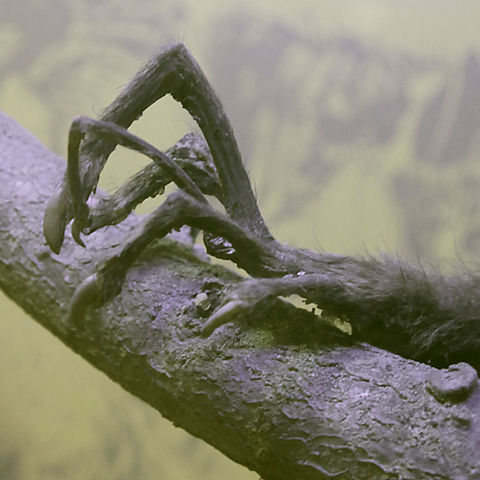
They are classified as endangered animals because they are killed because of their scary appearance and the destruction of the rainforest and may go extinct if nothing is done to preserve them.
- Monkey Name: Aye-aye
- Type of monkey (Family): Daubentoniidae
- Type of monkey (Genus): Daubentonia
- Species Name: madagascariensis
- Adult Body Weight (lbs): 6
- Adult Body Weight (Kg): 2.73
- Size (Inches): 15.74804
- Maximum lifespan (years): 24.3
- Newborn Weight (lbs): 0.26
- Pregnancy Duration (months): 5.5
- Typical Group Size: 1
- Diet type: Omnivorous
- Monkeys per Square Mile: 15.3
What Apes Live In Rainforests And What Do They Eat?
The group of Apes includes Gibbons, Chimpanzees, Orangutans, Bonobos, Gorillas, and our own species (humans)! All apes are quite intelligent, and they have the ability to use tools, make decisions for themselves, and solve problems.
Apes, like humans, are usually omnivorous, eating both plants and animals as food. For most apes, however, their diet consists mainly of plant material
Gibbon
The Gibbons are a group of apes that live in the rainforests of Southeast Asia and parts of China.
In the rainforest, they mainly eat fruit, however, they also occasionally supplement their diets with leaves, flowers, insects, and the eggs of smaller birds.
Contrary to the other apes listed here, they belong to the group of “lesser apes” (Hylobatidae) that are smaller and spend most of their lives climbing trees. Gibbons are very active, and they are capable of swinging and leaping from tree to tree at impressive speeds.
Gibbons also differentiate themselves from the other great apes by forming stable mating pairs, rather than adhering to the more loose partner ethics of their great ape cousins.
Orangutan
The Orangutan is a type of ape that lives in the rainforests of Borneo, Sumatra and Southeast Asia. These apes are the largest living arboreal animals. They have reddish-brown hair, and their faces are covered in long white fur.
Orangutans diet mainly consist of different fruits growing in the tropical rainforest such as durian fruit, figs, mangos and bananas. Occasionally, they will also eat insects making them omnivores instead of just herbivores.
Orangutans are very intelligent, and they are known for being able to use tools and solve problems and catch insects such as ants.
Chimpanzee
The Chimpanzee is a type of ape that lives in the rainforests of Africa. Chimpanzees are the most common type of ape, and they are known for being highly intelligent and social animals.
Chimpanzees eat a varied diet of fruits, leaves, seeds, bark, flowers and insects that are found in the rainforest. They have even been seen eating honey!
Gorilla
The Gorilla is a type of ape that lives in the rainforests of Africa. Gorillas are the largest living land animals on Earth.
Gorillas mainly eat plant material such as leaves, fruits, flowers and stems. They are omnivores so they may also eat insects such as ants occasionally, although they really seem to prefer bamboo overall.
Male gorillas can weigh up to 400 pounds, and females can weigh up to 200 pounds! They have black fur, and their faces are covered in long silver hair. Gorillas are very social animals, and they live in groups that can number up to 50 individuals.
Bonobo
The Bonobo is a type of ape that lives in the rainforests of the Democratic Republic of Congo.
Bonobos are very similar to Chimpanzees, however, they are considered to be more peaceful and less aggressive than their cousins.
Bonobos eat much of the same diet as chimpanzees. They eat mostly fruits and other plant material but will also eat insects, small mammals and have even been observed to eat mushrooms and fish!
They use tools, make decisions for themselves, and solve fairly complex problems.
What are the differences between Apes and Monkeys?
The main difference is that apes are more intelligent and can use tools, while Monkeys cannot. Otherwise, their diets are quite similar as they evolved from the same common ancestor.
Apes have bigger brains compared to monkeys. The more complex brain also allows apes to communicate, which allows them to form more complex social groups than monkeys do. It also allows them to gather food in a more coordinated manner than most monkeys would be able to.
Other anatomical differences between apes and monkeys include:
- A tail – monkeys have tails and apes do not!
- Apes have larger and heavier bodies.
- Apes have the ability to walk upright using only their hind legs.
- They also tend to move around threes by swinging rather than climbing.
- Apes have appendixes, while monkeys don’t.
To understand how apes and monkeys are related, we need to look into the two groups or types of currently living monkeys. These are divided into the “new world” and “old world” monkeys and the apes diverged from the Old World monkeys approximately 27 million years ago.
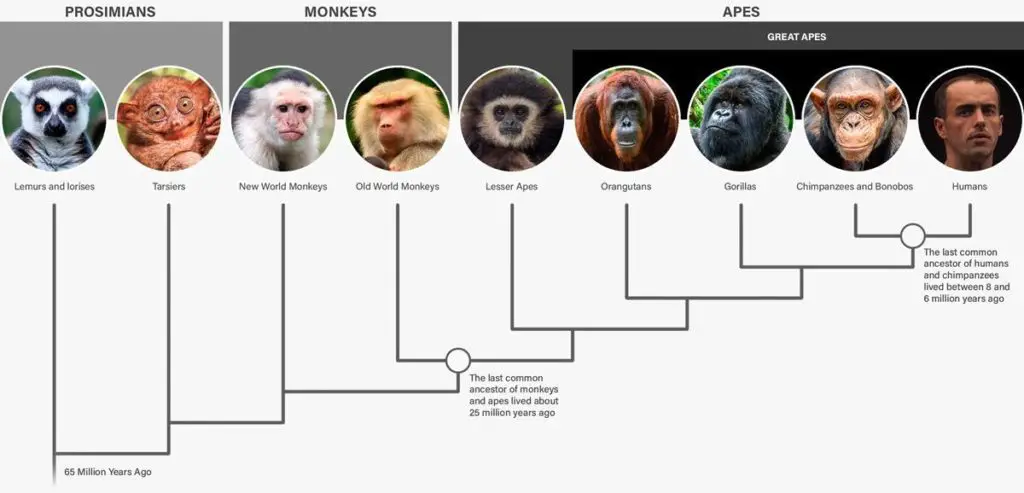
The main thing that sets our diet apart from the diet of monkeys and other apes is that we have evolved our technologies a couple of steps further!
Read more about the differences between apes and monkeys, new and old world monkeys in my article on all the different types of monkeys!
Why Does The Diet of Apes And Monkeys Differ From That Of Humans?
Well, if you go far enough back in time, the diet of humans and monkeys, or rather apes, were the same!
As the quality of our human diet rose, the requirements of our digestive tract declined and left us with significantly smaller, less energy demanding, intestines along with smaller teeth and weaker jaws compared to other primates of similar body size.
This trade off between “expensive” tissues is also correlated with diet quality in other primates e.g. monkeys that eat a more human like omnivorous diet tend to have bigger brains and shorter digestive tracts than their relatives adapted to leaf and fruit diets.
It it still controversial whether the inclusion of meat and starch-rich tubers in our diets alone was enough to induce these remarkable anatomical changes.
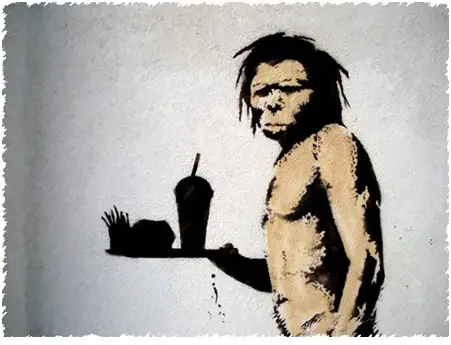
Archaeological evidence confirms that our ancestors have had control of fire for at least 250,000 years, although some evidence suggests the use of fire as early as 1.5 million years ago.
However, the dramatic changes observed in H. erectus ~1.6 million years ago, suggest a rapid adaptation that is unlikely to be attributed to an improved raw diet alone.
Recent studies have shown that the effect of food processing, and cooking in particular, substantially increases the energy availability of numerous stable foods eaten by our ancestors e.g. the yield of many starchy foods is increased by at least 30 % and even higher for animal-derived protein-rich foods!
The cultural transition from hunter-gatherer to agrarian might seem like a radical transition, but the relatively recent dramatic change introduced by the industrial revolution, only 7 generations ago, is what truly challenges our ancient genomes.
Our modern diet is characterized by extreme industrial processing of food ingredients derived from highly domesticated plants and animals that, due to extensive breeding, differ substantially from their free-living relatives.
The modern western diet consists largely of refined cereals, vegetable oils, meat and dairy products which along with added salt, alcohol and simple sugars would be very unfamiliar to our ape and monkey ancestors!

